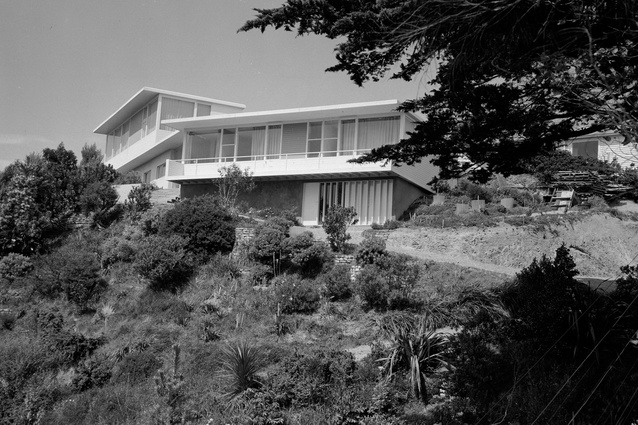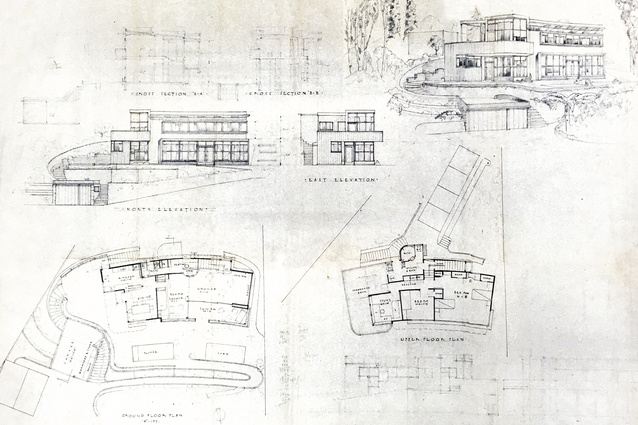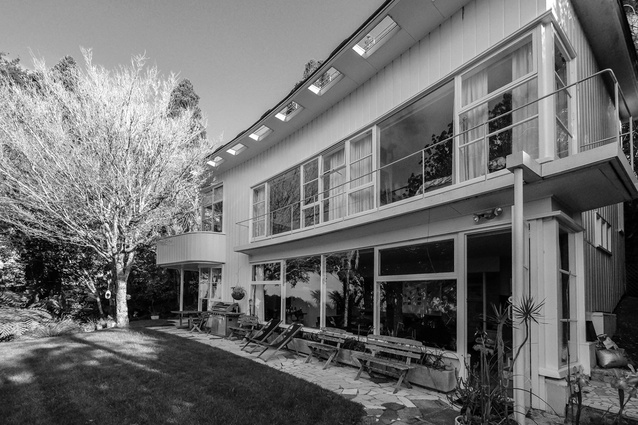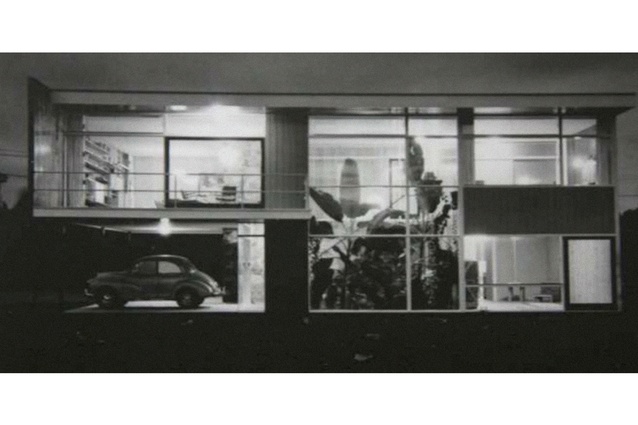Alien subversives
Gina Hochstein and Bill McKay re-examine the shunned place of post-war European émigré architecture in the International Style in New Zealand’s architectural history.
The émigré occupies a particular place between refugee and migrant. Refugees are fleeing their homelands, migrants are often seeking better lives elsewhere, but the term émigré has political connotations: often of forced or self-imposed exile from home. In the mid-20th century, European émigrés, fleeing fascist or communist regimes, played an important role in the creation of the modern era – but in countries other than their own. These exiles were often writers, artists, architects and scientists. Mies van der Rohe and Walter Gropius are perhaps the most famous modernist émigré architects, leaving Europe for the United States, but New Zealand hosted quite a few as well.
The best-known European modernist architects who settled in New Zealand include the Austrian Ernst Plischke, who left Europe with his Jewish wife Anna in 1939 following the Anschluss, the Nazi annexation of his homeland. He was joined by other émigrés, many of whom were Jewish and escaping the persecution of the Third Reich.
Helmut Einhorn, Friedrich ‘Fritz’ Eisenhofer, Friedrich Neumann, Friedrich Ost and Max Rosenberg settled in Wellington. Most, however, located themselves in Auckland, including Vladimir Cacala, Tibor Donner, Heinrich Kulka, Imric Porsolt, Gerhard Rosenberg and Odo Strewe (landscape architect). Many gravitated towards Auckland’s Titirangi, an important hotbed of modernist creativity in the post-war period. There, they were responsible for more than 30 significant modernist houses in the area, most designed for themselves or clients, as well as homes, office buildings and apartments in other parts of the city.
Many émigrés liked Titirangi in this post-war period because its cosmopolitan community was relatively sophisticated, intellectually progressive and arts-minded. They also enjoyed the semi-alpine forested environment, away from the conventional housing of the flatter Auckland suburbs and their more conservatively-minded inhabitants. The sloping, bush-covered sites
of the area were also cheap and the challenging topography encouraged innovation in house design. Titirangi inhabitants were interested in experimentation and the possibilities of the new promised by modernism. They were happy to engage with new architectural language that incorporated other aspects of the arts, such as painting, sculpture, furniture, ceramics and weaving.
At odds with Nationalists
While these émigrés were welcomed in Titirangi for their ideas and creativity, the International Style of modernism they brought with them was at odds with what was developing in New Zealand at the time. New Zealand artists, writers and architects embraced modernism as well but many were also searching for ways of expressing a nascent national identity after the Second World War when the country was gaining full autonomy from Britain.
The émigrés understandably had a distaste of nationalism, having experienced the negative side of it in the rise of European fascism and the conflict of war; they continued to work in the International Style. Plischke commented to architectural theorist Nikolaus Pevsner that his new home “goes through a sort of emancipation struggle, economically as well as intellectually. In architecture, the highest word on the list is ‘indigenous’ .”
The search for the local, he continued, “is all a bit difficult and the endeavour smells a bit like blood and soil” (McAloon, 2004). The latter is a direct reference to the Nazi nationalist slogan expressive of racist ideology tied to anti-Semitism.
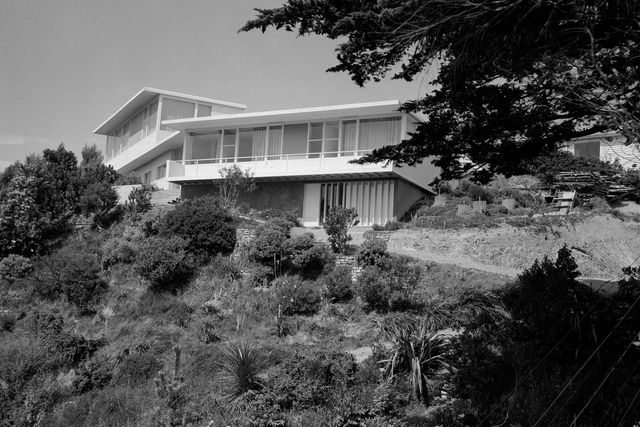
Broadly, the development of modernism in most of the arts in New Zealand split into two post-war streams of modernist thinking. One was focused on the International Style and the other on a sense of national identity. In the visual arts, for example, the painting practice of Milan Mrkusich represents the former and the work of Colin McCahon expresses the latter. This was also true of literature and music.
In pre-war architecture, modernist New Zealand architects such as Robin Simpson, Paul Pascoe and others favoured the International Style; however, in the 1940s, Pascoe argued for a new architecture to be more “expressive of national character” (Shaw, 1992, p. 24). After Simpson’s early death, his architectural partner Vernon Brown also became an advocate for an architecture expressive of national identity. This drive to produce an identifiably New Zealand modernism has marginalised the contribution of the more internationally minded modernists, including the work of some native-born New Zealanders, such as the firms Rigby Mullan and Mark-Brown Fairhead, which also operated in Titirangi.
How did national identity in architecture manifest itself? This architecture had climatically appropriate forms such as pitched roofs and verandahs. It used local materials, such as timber, dwelt on the needs and household arrangements of local people and referred to vernacular precursor forms such as milking sheds, woolsheds and Māori whare. Vernon Brown and the Group Architects were high-profile drivers of this aesthetic in the post-war period. They were also influential teachers at New Zealand’s only school of architecture and active in publication, criticism and commentary. In contrast, the work of International Style practitioners, both émigrés and native-born, often took the form of flat-roofed glass pavilions, using steel, concrete, marble and stone as materials.
Those keen on an architecture of national identity – what we call Regional Modernism today – emerged dominant in the area of the architect-designed house; they were, after all, the home team. Meanwhile, the work of the émigré architects has been sidelined in New Zealand history, although it is interesting that the International Style became mainstream in commercial and institutional architecture until the adoption of a more humanist style in the 1970s, such as in the work of JASMaD, Athfield and others.
Ernst Plischke
Austrian architect Ernst Plischke was perhaps the most famous architectural émigré to come to New Zealand before the war. Although at that stage famous in Europe, he was not particularly feted in New Zealand. Art historian and critic William McAloon describes his new home as somewhat unwelcoming of the émigré, who was sometimes suspected of being an enemy alien: “… as well as having to counter accusations of espionage, Plischke was required to explain to a confused constabulary that a consignment of steel tubing delivered to his house was for use in furniture and not the production of something more sinister” (McAloon, 2004).
Plischke refused to sit the exams for an architectural qualification that would be recognised in New Zealand, insisting that his six years’ training in Vienna, including study with the great modernist Peter Behrens, was superior to anything offered here. As a result, one of the country’s most significant architects, perhaps the one with the greatest international reputation, was never actually able to call himself one during his time here.
Like many émigré architects, Plischke was involved in government work, employed until 1947 on large projects such as apartment buildings, community centres and the planning of new settlements. New Zealand cities at the time were low-rise with suburban housing, unlike the multi-unit European urban environment with which Plischke was familiar. He was formative in his department’s experiments with density in the state housing programme and especially high-rise blocks of flats, claiming “the first continental European block of flats” (Plischke, 1989, p. 249). But apartment buildings such as these were viewed with suspicion, he said, claiming New Zealanders thought “only prostitutes or intellectuals wanted to live in them” (Tyler, 2008, p. 87).
Plischke published Design and Living in 1947, promoting modernism in architecture, furniture design and other aspects of post-war life. As a result of the frustrations of government work, he left and founded a practice with Cedric Firth, producing a significant International Style modernist building (Massey House, 1951–57) in central Wellington as well as a number of International Style houses around the city’s suburbs. He left New Zealand in 1963, returning to Europe as Professor of Architecture at the Academy of Fine Arts in Vienna. In the 1980s, he commented how xenophobic and hostile some New Zealanders had been to him and his form of “European high modernism” (Long, 2007, p. 264).
Some Auckland émigrés
Those émigré architects who settled in Auckland, including Jewish exiles Heinrich Kulka, Imric Porsolt and Gerhard Rosenberg, and others such as Vladimir Cacala, Tibor Donner and Odo Strewe (landscape architect), achieved a certain level of success in New Zealand. But none became well known nor were they highly thought of and featured in our architectural histories because of their adherence to the International Style rather than to Regional Modernism.
Jewish Czech architect Heinrich Kulka, a partner of Adolf Loos, was active in the development of the Raumplan and brought this idea of spatial planning to his modernist homes. Supported by Sir James Fletcher, he was employed as chief architect by Fletcher Construction and designed more than 100 commercial and 40 residential buildings. Kulka also brought with him new technologies suited to commercial and industrial modernism, such as those that enabled the introduction of natural light into factories through sawtooth roofing (Gatley, 2008, p. 52).
Another Czech, Vladimir Cacala, lived through the war and then studied at Prague University, where his architectural education was based on Bauhaus principles. Facing restrictions on private practice from the communist government, he fled, arriving in New Zealand in 1952. He worked at Brenner Associates, advocates of International Style design, before starting his own practice. There, he designed numerous houses as well as multi-unit European-style flats and apartments, incorporating modernist elements, such as large areas of glazing and colour, in stark contrast to the typical New Zealand timber or brick-and-tile-style house. His 1959 Blumenthal House features swathes of glass and cantilevered elements creating a light-filled and spacious home; its rectangles of primary colours earned it the nickname ‘Mondrian House’ after the De Stijl artist (Tyler, 2008, p. 91).
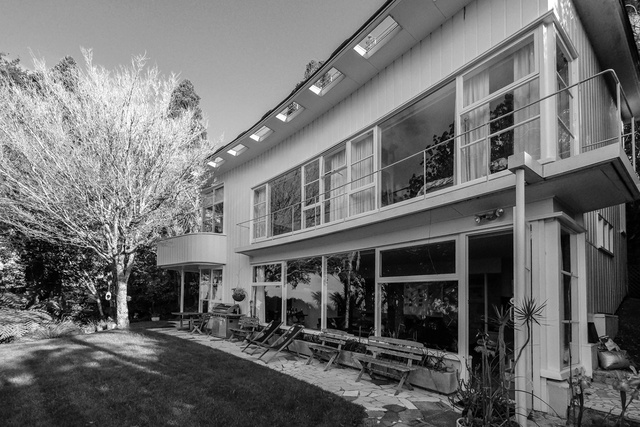
Émigrés out of step
Only in the last 20 years have émigré architects who practised in the International Style been acknowledged in historical research in New Zealand, thanks in particular to architectural historians Peter Shaw and Douglas Lloyd Jenkins, but more is coming to light through contemporary research. Partially, this is supported by a worldwide renewal of interest in classic modernism and the International Style, commonly called Mid-Century Modern, and the Retro-Modern aesthetic that has become prevalent in practice.
New Zealand’s émigrés expressed in their work a formal and international modernist vocabulary and this was a powerful symbol for articulating their own new start in a foreign country. But, it was out of step with the aspirations of the mainstream of architects in their new home.
As recently as 1998, the Auckland School of Architecture publication, Connections:
The house in the Auckland scene could still comment: “Continental modernism in New Zealand, as in the works of refugee architects and Ernst Plischke, never quite shook off an alien, dysfunctional relation to the New Zealand scene” as John Dickson put it (Dickson, 1998, p. 30). A second author, Peter Bartlett, agreed, finding the work “subversive” and “inappropriate for New Zealand and as pursuing too simplistic and formalist an agenda”, especially in the realm of house design (Bartlett, 1998, p. 23). The work of the émigrés was considered extraneous to New Zealand’s architectural direction and was sidelined in histories.
Why were émigré architects not well received and acknowledged as part of the historical narrative of New Zealand’s modernist period? Firstly, it was a result of war-time suspicion of the foreigner, as experienced by Plischke and others. Sometimes, this included anti-Semitism, with officials openly expressing their immigrant preferences. Edwin Dudley Good, Comptroller of Customs in the mid-1930s, for example, was quite explicit: “Non-Jewish applicants are regarded as a more suitable type of immigrant” (Beaglehole, 1988, pp. 15–16).
Secondly, as the only institution teaching architecture at the time, the Auckland School of Architecture was dominated for decades by nationalist/regionalist advocates, such as Mike Austin, Vernon Brown, David Mitchell, Richard Toy and Bill Wilson (of the Group). Even Gerhard Rosenberg, who joined the staff through his interest in Māori architecture, became interested in Regional Modernism.
The third reason, we believe, was the predominance of the house as the primary site of architectural expression in New Zealand architecture during the post-war period, rather than the larger commercial and institutional buildings being built in other countries. And, while both émigré architects and regionalist/nationalist architects of New Zealand operated in the housing scene, local architects dominated it through their sheer numbers. The International Style took over in commercial, industrial and institutional architecture, but the architectural battlefield, as one can see in a variety of writings from the 1940s onwards, was the architect-designed house.
Nevertheless, the culture from which the émigrés came and the architectural aesthetic they brought with them have now become part of New Zealand’s architectural history narrative; however, the extent of their achievement, particularly in the design of the house, is yet to be fully acknowledged. Considering events in the world today, not least the recent terrorist attack on two New Zealand mosques, this history is just as relevant today in highlighting this country’s prejudice and suspicion of those who would come here looking for better futures for themselves, their families and communities.
References
Bartlett, Peter. ‘The mid-century modern house in Auckland’, Connections: The house in the Auckland scene (Auckland: G4 Exhibiting Unit, 1998).
Beaglehole, Ann. A Small Price to Pay: Refugees from Hitler in New Zealand 1936–1946. (Wellington: Allen & Unwin, 1988).
Dickson, John. ‘Architectural modernism in New Zealand 1960–1990’, Connections: The house in the Auckland scene (Auckland: G4 Exhibiting Unit, 1998).
Gatley, Julia (ed.). Long Live the Modern: New Zealand’s new architecture 1904–1984
(Auckland: Auckland University Press, 2008).
Long, Christopher, Review of ‘Ernst Plischke: Modern Architecture for the New World – the complete works’, Journal of the Society of Architectural Historians, Vol. 66, No. 2 (June 2007).
McAloon, William. ‘In every dream home’. Retrieved from noted.co.nz/archive/listener-nz-2004/in-every-dream-home/
McKay, Bill and Gatley, Julia. ‘Buildings for the sub-tropics: The Group and other moderns’ in Julia Gatley (ed.), Group Architects: Towards a New Zealand architecture (Auckland: Auckland University Press, 2010).
Mitchell, David. The Elegant Shed: New Zealand architecture since 1945 (Auckland: Oxford University Press, 1984).
Plischke, Ernst. Ein Leben mit Architektur (Vienna: Löcker, 1989). Translation by Christoph Schnoor.
Schnoor, Christoph. ‘Ernst Plischke and the Dixon Street Flats’. In Proceedings of the Society of Architectural Historians, Australia and New Zealand: 32, Architecture, institutions and change, edited by Paul Hogben and Judith O’Callaghan, 2015.
Shaw, Peter. ‘Modernism in New Zealand architecture’. New Zealand Home & Building: The 1950s Show (Auckland: Auckland City Art Gallery/AGM, 1992).
Smith, Jack. No Job Too Hard: A history of Fletcher Construction, Volume II: 1940–1965 (Wellington: Steele Roberts, 2014).
Tyler, Linda, ‘Czechoslovakian crystal in pavlova paradise: Vladimir Cacala, 1926–2007’, Interstices 09, 2008.


